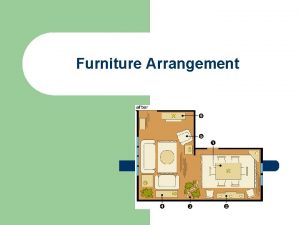Furniture Arrangement Furniture Arrangement l Activities that commonly







- Slides: 7

Furniture Arrangement

Furniture Arrangement l Activities that commonly take place in living areas: – l The ideal diameter for the primary conversation area: – l Conversation, recreation, dining, entertaining, hobbies, relaxing 8 -12 feet Secondary furniture grouping: – Seating for 2 -3 people, a piano, a desk or a chair for one person

Furniture Arrangement l Minimum dining size for four people. – l Space required to seat four to eight people and place a hutch and buffet in the room: – l 180 square feet Activities that take place in family rooms: – l 80 square feet Games, hobbies, tv viewing, dancing, active play Furniture to put in a family room: – Durable and easily-maintained furniture

Furniture Arrangement l Three purposes of the sleeping/private areas of a home: – l Three types of space that should be provided for each person in a bedroom: – l Sleeping, bathing, dressing Sleeping, storage, dressing Space that should be left on each side of a bed: – – 22 inches Exception: Twin beds can be made from one side

Furniture Arrangement l Recommended clearance space in front of a closet: – l 33 inches Dressing circle: – 42 inches

Furniture Arrangement l Function: – – l How can you combine functions with furniture arrangement? – – – l Living and dining areas can be combined. Drop-leaf table can double as a sofa table. Bedroom can serve as an office, dressing room, reading room, etc. Mechanical or architectural functions that must be considered when placing furniture: – l How a space will be used. Dictates the selection and arrangement of furniture. Air circulation vents, doors, windows, electrical outlets, phone jacks, television cables or antenna lines, fireplaces, and stairs How to control flow of traffic: – Place furniture at key locations to direct traffic flow or restrict or redirect traffic.

Furniture Arrangement l Create a feeling of balance in a room: – – – l Use furniture to emphasize a focal point: – – l Opposite walls should lend visual weight Furniture, doors, windows, and fireplaces should be balanced Visual mass is more important than dimensions Groupings should be balanced Do not overcrowd the room with furniture Group furniture around a focal point If the room lacks a focal point, use a piece of furniture as a focal point Groupings for seating arrangements: – Straight line, L-shaped, U-shaped, Box shaped, Parallel













